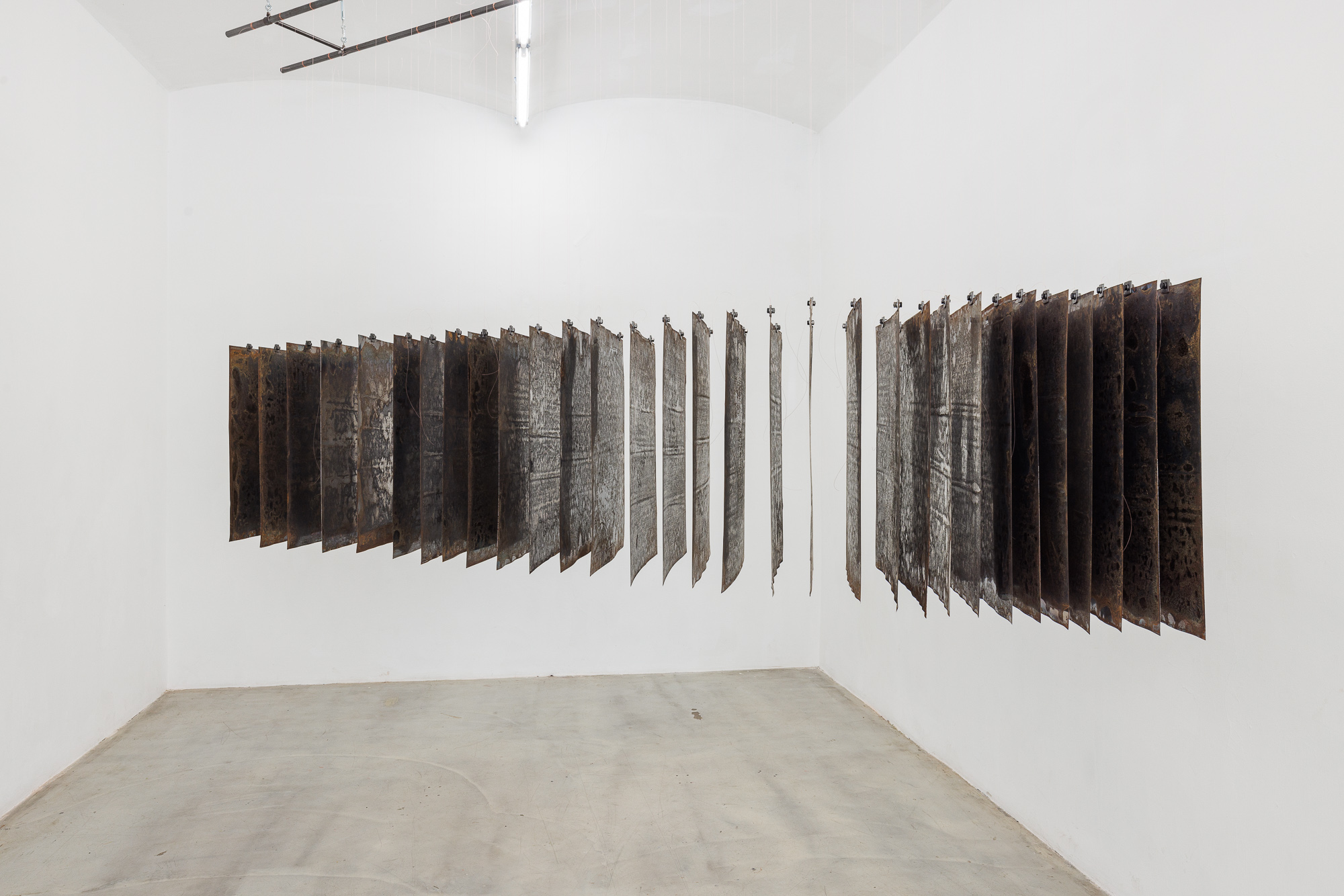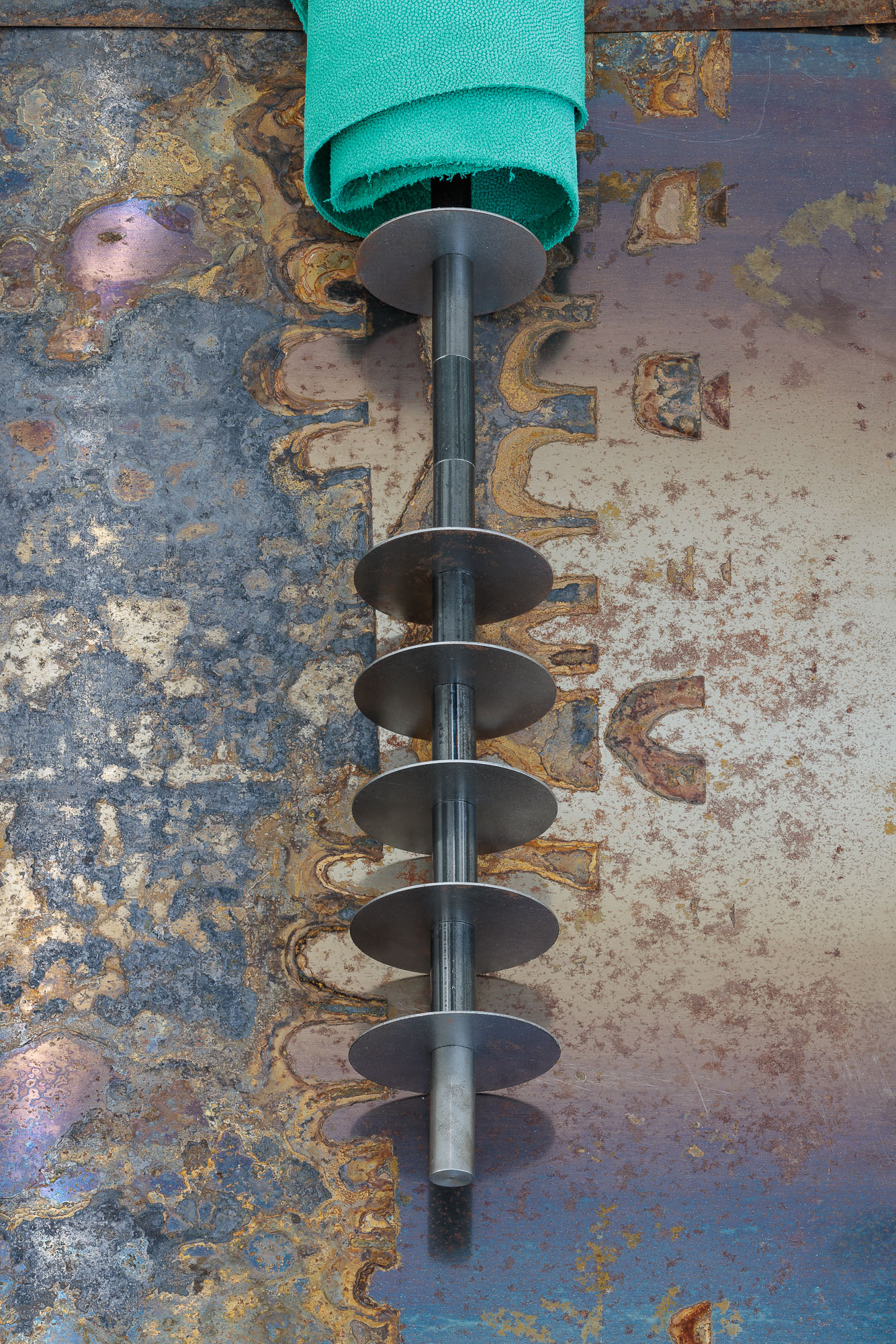Jun 2 - Jul 6, 2023
WAF Galerie, Vienna
Text by Johanna Luisa Müller
photography by Kunst-dokumentation











a material archive of exposure that flakes apart
When I started engaging with Bianca Phos' artistic work about a year ago, I came across the word pair 'Verletzungsmacht' (power to injure) – 'Verletzungsoffenheit' (vulnerability to injury). Without having previously clarified their definition, these terms involuntarily resurfaced in my examination of Bianca's exhibition SHARP DISPOSITIONS. But how can vulnerability and the power to injure be found in abstract installations of steel and leather? Who or what gets hurt? And who can hurt?
'Verletzungsmacht' describes the ability of a material, tool, system, or living being to unsolicitedly change specific properties of its environment. This includes forcefully violent gestures of inscribing oneself into the world, leaving traces on other things and living beings. Hurting them. In Bianca's installation A crop, a layer, this power becomes visible through the use of leather and the so-called Cutting Instruments. Since 2020, Cutting Instruments have shaped Bianca's artistic practice as method and object alike. They are reassembled from segmented steel modules: five-centimetre-long pieces, resembling the cartridges of a firearm, and discs, whose razor-sharp edges can leave painful wounds on their subsurface or on the skin. The danger of the discs meets the past violence suffered by the cows and goats when they were stripped off their skins. The human supremacy over other species becomes glaringly visible in the slaughtering, cutting, and disassembling of the animal body. Bianca has been repeatedly using leather since 2018, though in different forms, and places it – despite all inherent application of power – in a context of an openness to injury. Power and openness merge into each other. The skin is sensitive and changeable during an animal's lifetime and after its death. Every fold, every scar, every skin disease is inscribed on the lifeless leather like in a carefully maintained archive. This includes color changes resulting from the tanning process or embossed structural changes on the leather surface. ' The skin is an archive of past experience, a cartography of identity, a site of vulnerable pleasures, a carapace of often uncompromising pains, and a dynamic – if often embattled – screen onto which selves, others and societies project feelings of love, hate and everything in between.' (Marc Lafrance, Skin Studies. Past, Present and Future, 2018, p. 9)
'Verletzungsoffenheit', in this sense, refers to the ability of materials or living beings to absorb and display interventions from the world as well as past experiences. The sensitivity to make oneself permeable to one's environment. To realize positive and productive effects of the negatively connoted injury. To turn the weakness of vulnerability into strength. This ability is not only present in leather, but also in the rusted steel plates that appear in Sharp Disposition and A crop, a layer. Steel has long been considered a powerful metal that served railway construction and monumental architectural projects of the modern age. As a symbol of colonial, capitalist exploration of the world, steel is associated with unyielding strength and hardness. In contrast, cultural scientific research on materialism has found that steel should be thought of as less hard and injurious, but rather – due to its tendency to rust – as porous and open to injury. Rust is the expression of the gradual decomposition of steel, initiating its transformation into soft, powdery flakes. 'This is rust: a gathering of red that is followed by its own scattering; a material archive of exposure that does not keep itself but flakes apart and seeps away.' (Amelia Groom and M. Ty, Enduring Ornament, 2020, p. 140)
The steel plates of Bianca's installations also show the effects of rust. The thinly rolled spring steel plates, which were exposed to the weather for many years, have absorbed moisture, air, and dirt, which penetrated into the inner layers of the steel and transformed the material into reddish particles. On their surfaces, traces of the progressing rust process have emerged in different sizes, shapes, and colors, whose ornamental quality is particularly exhibited in Sharp Disposition. 31 steel plates are hung on thin, orange-colored nylon threads, so that each plate – despite their serial, industrial production – obtains individual quality. Rust here does not appear as a flaw, but as a productive transformation process. The corrosion of the steel signifies the decisive, productively redirected vulnerability of the seemingly unwavering metal. In A crop, a layer, the leather skin even wraps itself as a protective cover around the weakening steel objects. It encloses – though not completely – shields, and takes care of its underneath. Like living skin, the colored leather peels form a protective barrier against the outside environment. However, some discs are already rusted, corroborating that this is an unstoppable process of material transformation that the skin, as a permeable membrane, cannot stop. For skin does not have a closed defense against the outside world, but is constantly in contact with it, allows ins and outs, lets us be sensitive, feel hard, pointed, hot, wet things.
It is not without reason that in current cultural scientific discourses, both skin and rust are understood as archives. As materials capable of visibly rendering transformations and influences, they act as indicators of elapsed time. Powerful injurious actions leave – sometimes painful – traces on objects or living beings that show openness to injury. But this vulnerability is not to be understood as weakness, but as a form of transmission. As access to the past, as storage, as a place where historical layers overlap and can be decoded. The transmission of past events is also alluded to by the fossil trilobites that Bianca chose for the exhibition poster. These ancestors of today's crabs and spiders, which lived in the primordial ocean over 500 million years ago and eventually became extinct 250 million years ago, serve paleontologists to research an ecosystem that functioned long before the emergence of Homo sapiens. Trilobites share this archival function, as information about long past times remained stored in their fossil remains. 'As fossils are, in a way, time capsules that transport our imagination to unseen shores, lost in the sea of eons that preceded us. The time of trilobites is unimaginably far away, and yet we can dig out these messengers of our past and hold them in our hand. And, if we learn the language, we can read their message.' (Riccardo Levi-Setti, Trilobites, 1995, p. VII)
Johanna Luisa Müller, 2023
(translated from German)
(translated from German)